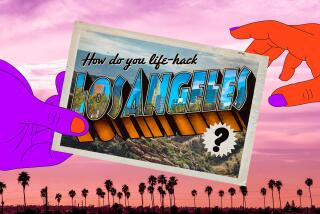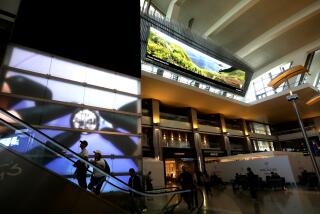New directions for travel in L.A.
- Share via
Re “Ending gridlock,” editorial, Jan. 5
Your editorial suggests that solo drivers should be charged a fee because the people causing the problem should pay the cost of its solution. The reality of life in Los Angeles is that while expensive mass transportation may take some drivers off the road, most drivers will never use any form of it because of the vastness of the region. This is not New York or Washington. If the destination is not within a few blocks of a bus or subway stop, people still have to get there by car. Solo drivers are not the cause of the problem; ineffective planning is.
Further, there is an ingrained culture of freedom and independence in Southern California that comes from someone being able to get into his car and drive when and where he wants. The solution is to make it easier for the solo driver by building more freeways or double-decking the ones we have.
Gary Aminoff
Studio City
--
The Times omits an important issue: the excessive cost of subway construction. An alternative method is elevated rail and busways. The San Francisco Bay Area’s BART has elevated railways with parks underneath, including bike and walking paths, benches and simple plantings. The trains are quiet and the parks are attractive to neighborhoods and commercial areas.
BART also has large free parking lots at convenient intervals to encourage the use of mass transit for those who need to drive. If the Bay Area can do it, so can Los Angeles.
Rhoda Holabird
Los Angeles
--
Rather than a new special tax on gas guzzlers, the state might consider vehicle registration fees that reflect the weight and engine displacement of vehicles. Heavier cars, SUVs and trucks produce more pollution and road wear, take up greater parking and road space and increase our dependency on imported petroleum. Owners of these vehicles should carry the increased financial and environmental costs by paying a greater share of the costs, as The Times suggests.
Graduated vehicle registration fees based on weight and engine displacement also would provide a disincentive for unnecessarily owning a heavy vehicle and would promote technologies that yield lighter and possibly safer transportation.
Fred Dorer
Bakersfield
--
The only way to end decades-old gridlock is to start thinking anew, because gridlocked traffic did not begin on our streets but in the gridlocked minds of bureaucracy. If we think more subways, buses, light rail and carpool lanes are the answer, then we’ve been asking the wrong questions. Further, raising new taxes to fund more old concepts only makes matters worse.
Instead, we need to elevate our thinking with an ultra-modern, high-speed monorail system built above our streets and freeways with private and public funding for one-fourth the price and completed in one-fourth the time of a subway. Composer John Cage said it best: “I can’t understand why people are frightened of new ideas. I’m frightened of the old ones.”
Robert L. Rosebrock
Brentwood
--
We must rethink the use of the present roadway systems. I’m talking about better use of our current roads. This proposal calls for a separation of semi-truck and automobile traffic at different times. Trucks should be mandated to travel during nighttime hours; cars should be limited (as much as possible) to daytime. This would free up all vehicles during their assigned times. Perhaps this idea upsets members of the unions and others with vested interests in building more freeways.
Maybe drivers would appreciate their “ownership” of roads during less busy and safer times. Are we brave enough to put this idea on the table for public discussion? Let’s do it right -- trucks at night.
Daisy McCleary
Banning






